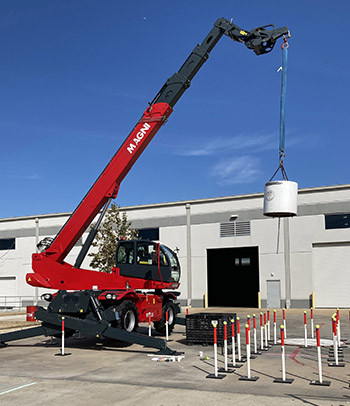The Telehandler Operator program offers designations for both fixed and rotating telehandlers.
February 1, 2024—In an industry where safety is essential to productivity, it’s crucial to know that all employees have the knowledge and skill required for the work they do. Telehandlers are on nearly every jobsite and crane yard around the country and likely one of the most widely used pieces of equipment. Unfortunately, until CCO released its new Telehandler Operator certification, there was no standard covering what operators should know to operate safely.
 That’s why CCO is excited about the Telehandler Operator certification. This certification, the only credential available that meets OSHA 1926 Construction and OSHA 1910 General Industry Rules, is designed to help employers document their OSHA compliance as well as enable telehandler operators to demonstrate their expertise and commitment to safety.
That’s why CCO is excited about the Telehandler Operator certification. This certification, the only credential available that meets OSHA 1926 Construction and OSHA 1910 General Industry Rules, is designed to help employers document their OSHA compliance as well as enable telehandler operators to demonstrate their expertise and commitment to safety.
The CCO Telehandler Operator program offers designations for two types of telehandlers: fixed and rotating. While standard telescopic handlers, also known as “fixed telehandlers,” have boom sections to lift and extend materials for placement, “rotating telehandlers” can lift, extend, and swing. This additional dimension of operation gives rotating telehandlers crane-like capabilities, making certification even more crucial.
Comprehensive Certification Process
Candidates seeking Telehandler Operator certification are required to pass both a written and a practical exam. The single written exam consists of 70 multiple- choice questions and must be completed within one hour.
Candidates have the option to take one of two practical exams: for Fixed Telehandlers or for Rotating Telehandlers. Passing the Fixed Telehandler practical exam leads to the Fixed Telehandler Operator (THF) certification designation. Passing the Rotating Telehandler practical exam awards the candidate both the Fixed Telehandler Operator (THF) and Rotating Telehandler Operator (THR) designations. This is because candidates demonstrate the skills required for both machines in taking the practical exam on a rotating telehandler.
Why Certify?
The OSHA Compliance Directive to the crane rule (1926 Subpart CC) indicates that OSHA intends to enforce operator certification when forklifts have a boom/ jib and a hoist. Additionally, under OSHA 1910.178, evaluation requirements already exist. CCO worked hard to bring certification requirements into alignment with industry standards, in this case ANSI/ ITSDF B56.6. This certification is the only certification available that meets all three standards, providing the highest level of compliance for employers, as well as the greatest flexibility for employees.
Studies have shown that personnel who hold CCO certification are more aware of safety factors and take better care of equipment. This results in fewer accidents and injuries and less down time with equipment. As with other CCO certifications, telehandler operator certification will likely lead to better insurance rates and compliance with insurance company directives.
With over 280,000 telehandlers currently in the field, the CCO Telehandler Operator certification is likely to become one of CCO’s most popular credentials.
Read more about the new Telehandler Operator certification, including how to get certified.